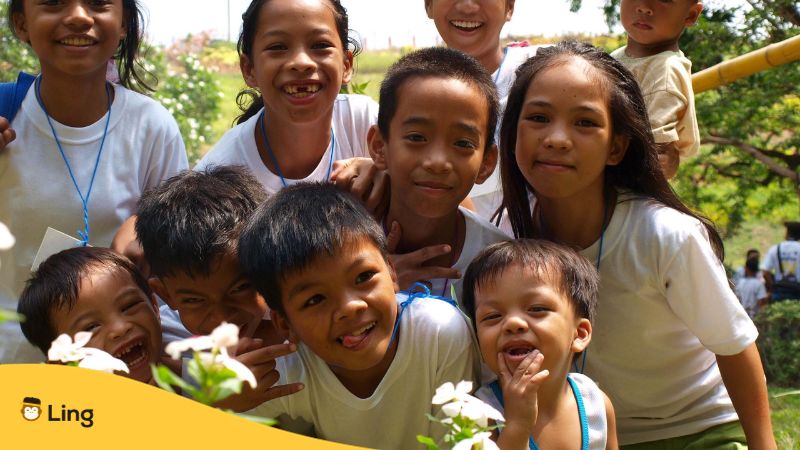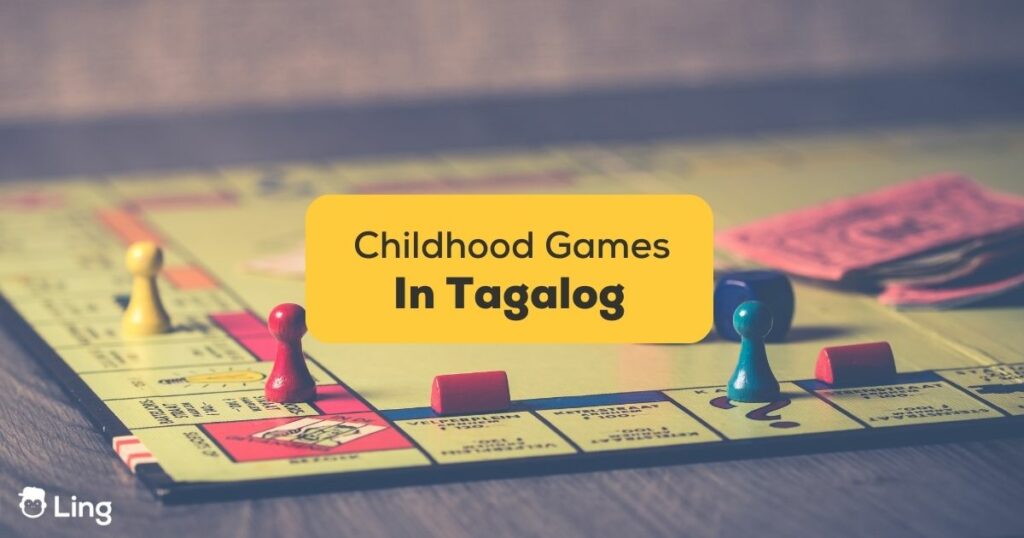Childhood is a time filled with nostalgia and memories. One of the things that brings back fond recollections for many Filipinos is the collection of traditional Tagalog childhood games. These games, passed down from one generation to another, hold a special place in the hearts of Filipinos and are an integral part of their cultural heritage. In this blog post, we will take you on a journey through each of those laro or games and learn a few Tagalog words associated with them. Let’s begin!
The Value Of Tagalog Childhood Games
Tagalog childhood games not only provide physical and mental benefits to children, but they also hold cultural value by connecting the present generation to their ancestors’ traditions and customs. These games are significant in maintaining a sense of community and preserving cultural heritage.
One of the most well-known Tagalog childhood games is “bahay-bahayan” or “playing house.” This game reflects the cultural practice of families in the Philippines, where children learn about the roles of women and men in society. It also reflects the Filipino value of respect for elders, as the game often involves children pretending to be parents or grandparents.
Another example of a Tagalog childhood game with cultural significance is “sungka.” It is a board game that involves strategy and counting skills. This game has been played in the Philippines for centuries and reflects the Filipino devotion to family, as it is often played in groups with members of the family.
“Agawan Base,” another Tagalog childhood game, teaches teamwork and cooperation, values that are held in high regard in Filipino culture. It involves two teams, where one tries to invade the other team’s territory, capture the flag, and take it back to their base safely.
Overall, Tagalog childhood games are not just about play; they hold cultural importance through fostering values, traditions, and customs that have been present in Filipino culture for generations. These games serve as a means of keeping the culture alive and transmitting the essence of Filipino traditions to the younger generation.

Tagalog Childhood Games
“Game” in Tagalog translates to “laro.” The word “laro” is a noun that refers to any play activity, sport, or game that is done for fun, excitement, or even competition. In Filipino culture, playing games is a significant part of childhood, and traditional games have been played for generations. Let’s get to know in the sections below some of the top outdoor games in the Philippines.
Piko (Hopscotch)
Piko is a classic game that has been enjoyed by Filipino children for generations. It involves drawing a pattern on the ground, usually with chalk, and hopping through it. The pattern typically consists of a series of squares or rectangles, each numbered from one to ten. The objective is to successfully hop through the designated squares without stepping on the lines or losing balance. Piko not only enhances physical fitness but also improves balance, coordination, and counting skills.
Ten Twenty (Chinese Garter)
Ten-twenty is a traditional Chinese garter game enjoyed by both boys and girls. It requires at least three players and a thin garter about two yards long. To play the game, two players face each other from a distance, with the garter stretched around them to create parallel lengths. One player jumps over the garter while reciting the numbers from ten to one hundred. The game progresses through different levels, with the garter moving higher up the players’ bodies and more difficult stunts added.
Luksong Tinik (Jumping Over Thorns)
Luksong Tinik is a game that requires agility, flexibility, and precise timing. It is played by two teams, with one team sitting opposite each other, their feet touching and forming a high arch with their hands positioned on their hips. The opposing team takes turns jumping over the “thorns” created by the arch without making contact with them. The height of the arch increases with each successful jump. This game not only challenges physical capabilities but also builds teamwork and fosters trust among the participants.
Patintero (Filipino Tag)
Patintero is a popular game in which two teams compete against each other. The playing field is divided into grids, and the objective is for one team to cross the opponent’s grid without getting tagged. The opposing team tries to tag the members crossing their grid. This game requires strategy, quick thinking, teamwork, and quick reflexes. Patintero promotes communication and coordination among team members, as they strategize on how to strategically cross the grid and defend against being tagged.
Tumbang Preso (Knock Down The Prisoner)
Tumbang Preso is a game that requires accuracy, agility, and quick reflexes. It involves a group of players and a “prison guard.” The players aim to knock down a tin can placed in the middle of the playing area using a slipper or a soft object while avoiding getting tagged by the “prison guard.” If a player gets tagged, they become the new “prison guard.” This game not only tests individuals’ aim and throwing skills but also encourages evasion and quick decision-making.
Taguan (Hide And Seek)
Taguan is a simple yet timeless game that is played worldwide, including in the Philippines. It promotes creativity, imagination, and problem-solving skills. One player covers their eyes and counts to a pre-determined number while the other players find a hiding spot. After counting, the player who is “it” tries to find and tag the other players. The last player to be found becomes the next seeker. Taguan enhances observation skills, patience, and understanding of spatial awareness.
Langit Lupa (Heaven, Earth, And Hell)
Langit Lupa is a classic Filipino game commonly played outdoors by children. The game involves two teams, the attack team and the defense team, with two to ten or more players on each side. The objective is for the attack team to reach “langit” (heaven) by jumping from one elevated object to another while chanting “langit, lupa, impyerno” (heaven, earth, hell). The defense players, on the other hand, try to tag the attackers before they reach “langit.” If a player is tagged, they become part of the defense team. The game progresses as players attempt to outwit each other and reach “langit” without getting caught.
Sipa (Filipino Sepak Takraw)
Sipa is a traditional Philippine game that requires players to use their feet, knees, or any part of their body except their hands to keep a small object in the air. The object, called a “sipa,” is typically made of feathers or a ball with beans or lead inside. Players take turns kicking the sipa and trying to keep it from touching the ground. The player with the longest kick wins. Sipa enhances foot-eye coordination and promotes physical activity.

Common Tagalog Games For Playing Childhood Games
Want to play traditional Philippine games while speaking with the locals? Here are the best words to use:
| English | Tagalog | Meaning |
|---|---|---|
| Sing | Kumanta | In some games, singing is required, such as in the Filipino children’s game, “Bulungan mo ako,” where players sing to secretly choose the “it” or the “catcher.” |
| Dance | Sumayaw | Certain traditional Filipino games require dancing, such as “Tinikling,” where players have to step over and dance between bamboo poles as they are being clapped together. |
| Knockdown | Tumba | A term used to describe games where players have to knock down targets or objects, like in “Tumbang Preso,” where players have to knock down a tin can using a flip-flop. |
| Pass | Pasa | A term used to describe the act of passing the ball or object to another player in games like basketball or patintero. |
| Rock, Paper, Scissors | Bato, Papel, Gunting | A game that is used to settle a dispute or as a game of chance by making a hand gesture representing one of the three items. |
| Count | Bilang | Counting is an integral part of many Filipino games, such as “Agawan Base.” |
| Bet or Wager | Taya | Wagering or betting adds an extra level of excitement and competition to games like “Pera o Bayong.” |
| Chase | Habulin | Games like tag or “Piko” involve chasing other players around. |
| Throw | Tapon | Throwing is required in games like “Sipa” or “Tumbang Preso.” |
| Take back or Retrieve | Bawi | A term used in games where players can retrieve a lost point or move, like in chess or “Ten-Twenty.” |
| Follow the leader | Sunod-sunod | A term used in games like “Bahay-Bahayan” or “Langit-Lupa” where one player is designated as the leader and others have to follow. |
Learn Tagalog With Ling
The Tagalog childhood games we covered above are not only a source of entertainment but also provide opportunities for physical activity, cognitive development, social interaction, and the nurturing of essential life skills. They have been cherished by Filipino children for generations, and their popularity continues to endure, even in the digital age.
If you want to learn more about traditional Filipino games and the country’s amazing language, download the Ling app from the App Store or Play Store to get started. The app has learning materials for various Tagalog topics and is perfect for those who want to deepen their knowledge of Tagalog and 60+ other languages. Give it a try now!



































































